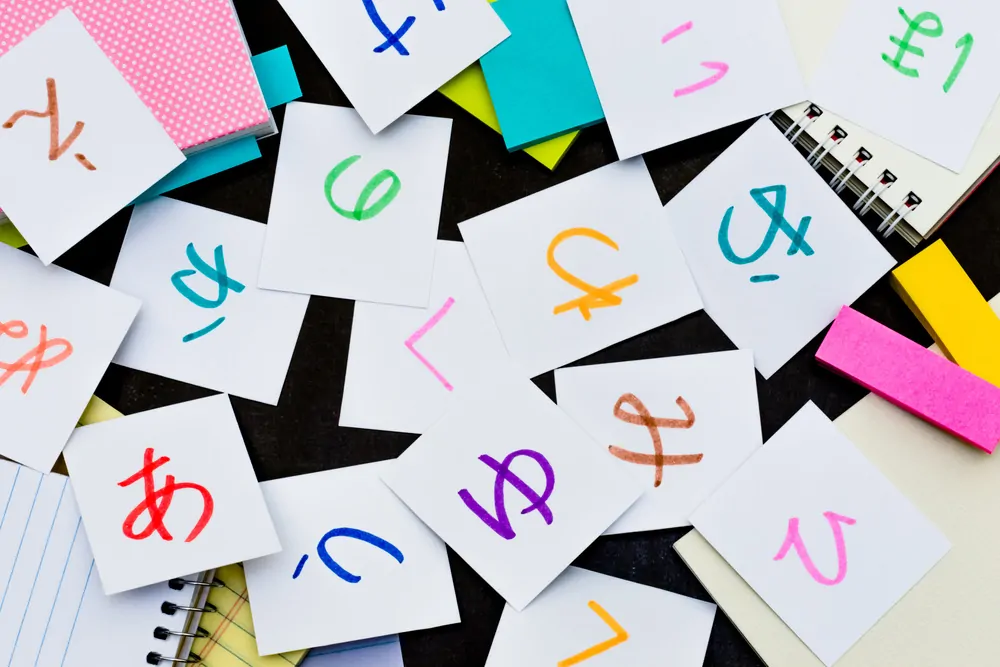Have you ever wanted to write your name in Japanese? It’s one of the first things you want to learn when you start studying Japanese, and it can be an enjoyable experience looking for the correct characters!
This blog post will discuss how to write Japanese foreign names. First, we will discuss the different types of characters that can be used when reading and writing Japanese.
Then, we will focus on katakana characters- these are the characters that are explicitly used for writing words from other languages.
We will go over how each katakana character works and explain how to use them to write your name in Japanese. There might be some sounds in your name that don’t exist in Japanese- don’t worry; we’ll explain how to deal with that too.
The 3 Japanese writing systems
When you start learning Japanese, you quickly learn that there are three different Japanese alphabet: kanji, hiragana, and katakana.

Kanji are the Chinese characters introduced to Japan centuries ago and are still in use today. Each kanji is associated with a specific idea or meaning and can have many different pronunciations depending on what kinds of characters come before or after it. By the way, you would need to know at least 2000 plus kanjis to be able to read the Japanese newspaper. In comparison, hiragana and katakana are much simpler to remember.
Hiragana are primarily used to write native Japanese words, words that don’t have a kanji representation, as well as grammatical elements (particles, verb endings…). They consist of 48 basic characters, and each character has one pronunciation only. This means you will always read them the same way. They are typically written in a curved, flowing style, making them easy to read. For this reason, they are often used for young children’s books because they cannot read kanjis yet.
If hiragana are used to write native Japanese words, katakana characters are used for writing foreign loanwords such as :
- テレビ (terebi) : TV (てれび in hiragana)
- フェリー (ferî): Ferry (ふぇえりい in hiragana)
- アイスクリーム (aisukurîmu) : Icecream (あいすくりいむ in hiragana)
- ジョージ (jôji) : George (じょうじ in hiragana)
As a result, hiragana and katakana represent two different parts of the Japanese language and won’t be used to write the same words.
Since katakana are for foreign words, they offer a bit more possibilities when it comes to pronouncing sounds that initially don’t exist in Japanese. Apart from that, hiragana and katakana are very similar in terms of pronunciation.
Using Katakana
Just like hiragana, katakana consist of 48 basic characters:
| Katakana | Sound | Katakana | Sound | Katakana | Sound | Katakana | Sound | Katakana | Sound |
|---|---|---|---|---|---|---|---|---|---|
| ア | A | イ | I | ウ | U | エ | E | オ | O |
| カ | Ka | キ | Ki | ク | Ku | ケ | Ke | コ | Ko |
| サ | Sa | シ | Shi | ス | Su | セ | Se | ソ | So |
| タ | Ta | チ | Chi (tchi) | ッ | Tsu | テ | Te | ト | To |
| ナ | Na | ニ | Ni | ヌ | Nu | ネ | Ne | ノ | No |
| ハ | Ha | ヒ | Hi | フ | Fu | ヘ | He | ホ | Ho |
| マ | Ma | ミ | Mi | ム | Mu | メ | Nu | モ | Mo |
| ラ | Ra | リ | Ri | ル | Ru | レ | Re | ロ | Ro |
| ヤ | Ya | - | - | ユ | Yu | - | - | ヨ | Yo |
| ワ | Wa | ン | N | ヲ | O (wo) | - | - | - | - |
The chart above shows five vowels (a, I, u, e o) and a few consonants (k, s, t, h, m, n, r, y, w, f). Japanese generally don’t separate vowels and consonants, so you will almost always find that one katakana equals one syllable.
This is why consonants are always attached to a particular vowel except for ¨ン¨ (n), which can be used alone.
It is also possible to create new sounds just by adding small symbols to basic katakana.
For example:
- If you add the symbol ¨ after the katakana ¨ka¨ (カ), it will become ¨ga¨ (ガ)
- If you add the symbol ° after the katakana ¨ha¨ (ハ), it will become ¨pa¨ (パ)
- If you add the symbol ァ after the katakana ¨fu¨ (フ), it will become ¨fa¨ (ファ)
- If you add the symbol ャ after the katakana ¨shi¨ (シ), it will become ¨sha¨ (シャ)
Below is a chart with many examples of possible phonetic katakana alphabet and other symbol combinations to create various pronunciations.
| Katakana | Sound | Katakana | Sound | Katakana | Sound | Katakana | Sound | Katakana | Sound |
|---|---|---|---|---|---|---|---|---|---|
| ガ | Ga | ギ | Gi | グ | Gu | ゲ | Ge | ゴ | Go |
| ザ | Za | - | - | ヅ | Zu | ゼ | Ze | ゾ | Zo |
| ダ | Da | ディ | Di | デュ | Du | デ | De | ド | Do |
| バ | Ba | ビ | Bi | ブ | Bu | ベ | Be | ボ | Bo |
| パ | Pa | ピ | Pi | プ | Pu | ぺ | Pe | ポ | Po |
| ファ | Fa | フィ | Fi | フ | Fu | フェ | Fe | フォ | Fo |
| ジャ | Ja | ジ | Ji | ジュ | Ju | ジェ | Je | ジョ | Jo |
| シャ | Sha | シ | Shi | シュ | Shu | シェ | She | ショ | Sho |
| チャ | Cha (Tcha) | チ | Chi (Tchi) | チユ | Chu (Tchu) | チェ | Che (Tche) | チョ | Cho (Tcho) |
Moreover, in Japanese, you can prolong the sound of a vowel by using the character ¨ー¨. For example, the word for “cake” in Japanese is the same as in English and is written ¨ケーキ¨ (kêki) with a long ¨e¨.
- If we wanted to make the second sound longer, it would be written as ¨ケキー¨.
- When writing a long sound with the English alphabet, you can either add a ¨^¨ on the letter (like in kêki) or write the letter twice (like in keeki).
If you want to emphasize a consonant sound, you can add a little ¨ッ¨ (tsu) before it. For example, the word for “match” in Japanese is also borrowed from English and is written ¨マッチ¨ (macchi).
- By adding the little tsu, we’re making it clear that the katakana coming just after it should be pronounced with a hard sound, not a soft one.
- When using the English alphabet, the doubled consonant will just be written twice, like in ¨macchi¨.
Writing Your Name in Japanese
Now that you have an idea of all the sounds you can come up with using katakana let’s see how to write foreign names in Japanese. The first thing you need to do is figure out the pronunciation of your name by looking for the right katakana in the charts above. This can be tricky because there might be some sounds in your name that just don’t exist… This means you have to adapt your name to the available sounds.
For example, the “L” sound doesn’t exist in Japanese, so it will be replaced with the “R” sound, which is the closest in terms of pronunciation. That’s why Japanese people sometimes have a hard time making a difference between ¨light¨, ¨right¨, and ¨write¨ and tend to pronounce the three words in the same way: ¨raito¨ (ライト).
The same goes for the “V” sound, which is usually replaced with the “B” sound. That’s why the word ¨video¨ is pronounced ¨bideo¨ (ビデオ) in Japanese. There is actually a way of writing the ¨V¨ sound in katakana using ヴ+ a small vowel like ァ,ィ,ゥ,ェ orォ. But to be honest, Japanese often pronounce it ¨B¨ no matter what way you write it because it’s easier for them.
Here are some common substitutions that are made when writing foreign words in Japanese:
- The L becomes R, and Leo becomes Reo (レオ)
- The V becomes B, and Victor becomes Bikutâ (ビクター or ヴィクター)
- The Th becomes S, and Theodore becomes Seodoa (セオドア)
- The X becomes Kks, and Alex becomes Arekkusu (アレックス)
Note that sometimes, the obvious choice might not be the right one. For example, you would think the ¨r¨ of Theodore would be written with the Japanese ¨r¨ sound like this: セオドル (seodoru). However, the Japanese see ¨oa¨ as the closest to the original ¨r¨ sound, thus writing Theodore as セオドア (seodoa).
Once you have the pronunciation of your Japanese name figured out, you can start looking for the right katakana characters. Remember, each katakana character has only one pronunciation, so you will always read them the same way.
In addition, the Japanese don’t use spaces between words, so they separate one’s first name and family name using a ¨・¨ like this: マイケル・スミス (Michael Smith).
Common Examples of Foreign Names
To help you find the right way of writing your name, we created a list of common first and family names you can use as a reference:
Emily Miller エミル―・ミラー
Harry Brown ハリー・ブラウン
Noah Johnson ノア・ジョンソン
Lucas Anderson ルーカス・アンダーソン
Emma Taylor エマ・テイラー
Maria Davis マリア・デイビス
Charlotte Williams シャーロット・ウイリアムズ
Oliver Jones オリバー・ジョーンズ
Muhammed Thomas ムハンマド・トマス
Sofia Martin ソフィア・マーティン
Benjamin White ベンジャミン・ホワイト
George Smith ジョージ・スミス
Jack Robinson ジャック・ロビンソン
To Conclude on Writing Foreign Names in Japanese
So you see, Japanese katakana are not that difficult to use. Sometimes you might have some trouble finding the character with the exact pronunciation you are looking for, but there is always a way to get at least close to your real name.
Now, you hopefully know how to write your name in Japanese. If you have any questions or are still unsure which katakana to use to write your name, please feel free to leave a comment, and we will do our best to help.
And if you want to learn more about the Japanese language, be sure to check out some of our other articles!




Leave a Comment